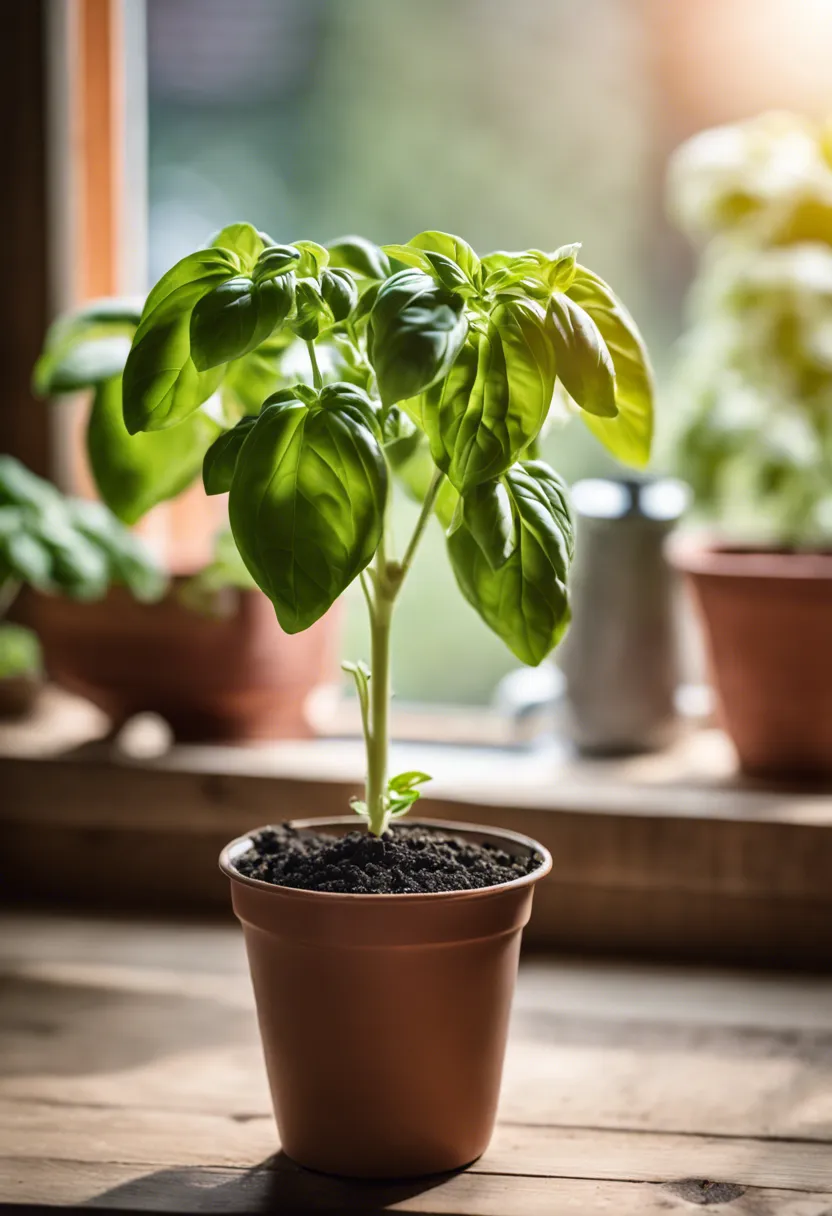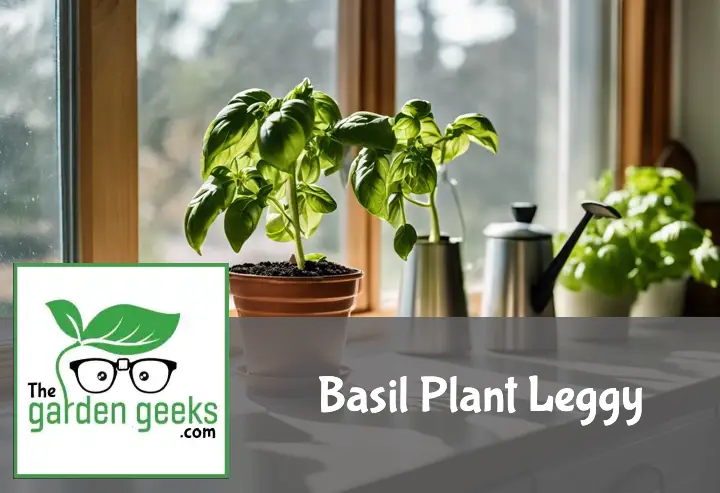Ever looked at your basil plant and thought, “Gosh, you’re looking a bit leggy today?” No? Just me then. Well, if you’ve ever wondered why your Basil Plant Leggy is stretching out like an aspiring runway model instead of growing into the robust herb you envisioned, then this blog post is for you.
In this green-fingered journey, we’ll dive into the reasons behind your basil’s supermodel aspirations and how to bring it back down to earth. So stick around; there’s a lot to learn about Basil Plant Leggy? (How to Revive it).
Key Takeaways
- A “leggy” basil plant is one with long, thin stems and few leaves, often due to insufficient light.
- To revive it, move the plant to a sunnier location or use artificial lights.
- Prune back the leggy stems to promote bushier growth.
- Ensure proper watering and avoid over-fertilization as it can cause rapid, weak growth.
- If the plant is severely leggy, consider propagating new plants from cuttings.

What Does It Mean When a Basil Plant is Leggy?
When your basil plant leggy situation arises, it’s like the plant’s screaming for a haircut. It means the basil’s grown too tall and thin, kinda like a teenager during a growth spurt, but without the awkwardness.
Understanding the Term ‘Leggy’
So, what’s up with being leggy? In plant lingo, it’s when your basil decides to go all skyscraper on you. This isn’t just about aesthetics; a leggy basil plant struggles more than a fish out of water. The issue here is that all that energy going into growing tall doesn’t do much for the leaves, which is where all the tasty action happens.
Plus, this can signal some underlying growth problems in basil, like not enough light or too much love with the water can.
Identifying a Leggy Basil Plant
Spotting a leggy basil plant isn’t rocket science. Look out for stems that seem more interested in touching the sky than staying grounded. These stretched-out stems are usually accompanied by leaves that are few and far between – think of a tree in winter rather than lush summer greenery. This sparse foliage is your clue that something’s off balance in your basil plant care routine.
Why Do Basil Plants Become Leggy?
Ever wondered why your basil plant leggy issues are popping up left and right? It’s not just you, trust me. These green buddies can get a bit high maintenance, craving attention for light, water, nutrients, and even how you snip them.
Lack of Adequate Light
When basil plants don’t get their sunbath, they start reaching for the stars – literally. They stretch towards any light source they can find, resulting in those spindly legs we’re trying to avoid. Sunlight requirements for basil aren’t just a fancy demand; they’re essential for keeping your plant compact and lush.
To dodge those preventing spindly basil plants scenarios, ensure your leafy friend gets at least 6 hours of sunlight daily. Finding that sweet spot of optimal lighting for basil growth might just turn your leggy basil into the bushy beauty it’s meant to be.
Overwatering or Underwatering
Watering is like walking a tightrope; too much or too little, and you’ll see your basil go all lanky on you. Overwatering symptoms in basil include yellowing leaves and a general look of despair (we’ve all been there). On the flip side, underwatering effects on basil make it droopy and sad-looking.
The trick is finding that Goldilocks zone of watering – not too much, not too little. Keeping a consistent watering tips for healthy basil routine helps maintain the moisture balance perfect for robust growth without encouraging it to become the next beanstalk legend.
Nutrient Deficiency
Think of nutrients as the secret sauce to preventing your basil from turning into a lanky mess. Without enough food, your plant starts stretching out in search of more sustenance, leading to weak stems and sparse leaves.
Spotting signs of malnutrition in basil early can save you a lot of headaches down the road. A good feed with balanced fertilizer covers those essential nutrients for robust basil growth, giving it the strength to stand tall – well, as tall as a bushy herb can stand.
Improper Pruning
Pruning isn’t just about playing barber with your plants; it’s crucial for avoiding that dreaded leggy look. Cutting back your plant incorrectly can encourage it to grow in all sorts of wonky directions. But fear not! With some simple pruning techniques for basil, you can promote more bushy and compact growth instead of letting it sprawl uncontrollably.
Regular trims encourage fuller growth by telling your plant where its energy should be focused—think of it as directing traffic towards denser foliage rather than letting it wander off into legginess land.



How to Revive a Leggy Basil Plant?


If your basil plant leggy situation has got you down, don’t fret! With a few tweaks to its care routine, your basil can go from lanky to lush in no time.
| Action | Description | Frequency |
|---|---|---|
| Pruning | Trim back the top third of the plant to encourage bushier growth. Remove any flower buds to direct energy back to the leaves. | As needed, when the plant appears leggy or starts flowering |
| Proper Lighting | Ensure the plant receives at least 6-8 hours of direct sunlight per day. Consider using a grow light if natural light is insufficient. | Daily |
| Correct Watering | Water the basil when the top inch of soil feels dry to the touch. Avoid overwatering, which can contribute to leggy growth. | Varies depending on conditions |
| Fertilization | Feed your basil plant with a balanced liquid fertilizer every 4-6 weeks during the growing season. | Every 4-6 weeks during growing season |
| Repotting | If the plant is root-bound or the soil is depleted, repot into a slightly larger container with fresh potting mix. | As needed |
Now, lets dive in more detailes for every step
Correct Pruning Techniques
Pruning isn’t just about aesthetics—it’s a crucial strategy for combating legginess in basil plants. By cutting back the top third of the plant, you encourage it to grow bushier and denser, rather than taller and sparser. Start pruning by snipping above a pair of growing leaves to promote the development of new stems from that spot.
This practice not only helps manage the height and shape of your basil but also leads to a fuller plant with more leaves for harvesting. Remember to remove any flower buds to focus the plant’s energy on foliage growth. Regular pruning combats legginess and maximizes the plant’s leaf production.
Adjusting Light Exposure
Proper lighting is essential for preventing your basil from becoming leggy. The plant needs about 6-8 hours of direct sunlight daily to thrive. When growing basil indoors, ensure it’s placed near a south-facing window or supplement with grow lights to mimic optimal outdoor conditions.
Adequate light exposure helps the basil grow compactly and healthily, preventing it from stretching out and becoming leggy.
Regulating Watering Practices
Watering your basil correctly is critical to avoid legginess. The plant requires just the right amount of water – not too much and not too little. Ensure the soil is moist but not waterlogged by checking the top inch for dryness before watering.
Maintaining this balance helps prevent root issues and supports overall healthy growth. By regulating your watering practices, you ensure your basil has the necessary hydration to grow robustly without becoming leggy.
Providing Essential Nutrients
Feeding your basil plant is akin to providing it with a diet rich in essential nutrients. Apply a balanced liquid fertilizer every 4-6 weeks during the growing season to support dense and vigorous growth.
Proper fertilization provides the basil with the necessary nutrients to prevent it from becoming leggy and sparse. Incorporate this feeding routine into your plant care to maintain a healthy and productive basil.
Repotting for Health and Growth
If your basil plant is root-bound or the soil has become depleted, repotting may be necessary. Choose a slightly larger container and fresh potting mix to give your basil new room to grow and access to nutrients. Repotting can rejuvenate a leggy plant by providing it with a fresh environment conducive to growth.
This step is especially crucial if you notice the soil drying out too quickly or the roots becoming cramped. A new pot and fresh soil can make a significant difference in the health and appearance of your basil plant.
By incorporating these practices into your care routine, you can revive a leggy basil plant and encourage healthier, more vigorous growth.
Can You Prevent Your Basil Plant from Becoming Leggy?
Absolutely! Keeping your basil plant leggy at bay is all about giving it a little TLC in the right areas. Think location, hydration, food, and a good haircut. Let’s dive into how you can keep your basil looking more like a lush bush than a spindly twig.
Choosing the Right Location for Your Basil Plant
Picking where your basil calls home is crucial. These green buddies love soaking up the sun, needing around 6 to 8 hours of sunlight daily. So, finding a sunny spot is key to preventing leggy seedlings. Whether you’re planting outdoors or keeping it inside by a window, make sure it’s getting plenty of light without being scorched by the midday sun.
But hey, not just any sunny spot will do. Protection from harsh winds and too much rain can also prevent your basil from stretching out like it’s trying to grab the sun itself. So, think about a location that’s kind of like Goldilocks’ porridge – just right.
Regularly Checking Soil Moisture Levels
Watering your basil is kinda like feeding a cat – too much or too little, and they’ll let you know they’re not happy. To avoid making your basil go all lanky on you, stick your finger in the soil up to the first knuckle. Feels dry? Time for a drink.
Remember though, overwatering is basically throwing your basil a pool party it didn’t ask for. It can lead to weak stems and yes, that dreaded legginess. So aim for that sweet spot where the soil feels like a wrung-out sponge – moist but not soggy.
Ensuring Proper Nutrition for Your Basil Plant
Feeding your basil makes all the difference between it being all legs and no leaves or nice and bushy. A balanced diet of nutrients will do just that. Think of organic fertilizers or homemade compost as their favorite food.
Applying fertilizer every 4-6 weeks during growing season keeps them happy without going overboard on growth spurts (aka getting leggy). Remember, it’s about quality foliage over quantity here!
Adopting Appropriate Pruning Practices
Pruning isn’t just for fancy gardeners; it’s essential if you don’t want your basil looking like it’s trying to escape its pot. Pinching off the tops encourages more side growth leading to that bushy look we all love.
The best time to start this? When your plant has about 6 leaves on it – this tells it to grow outwards instead of upwards. Plus, regular trimming keeps those flowers at bay so your plant focuses on leaf production – flavor town here we come!


In The End
We’ve learned that a Basil Plant Leggy is like an overgrown teenager in need of a haircut. Pruning, proper light, and soil nutrition can give it the makeover it needs.
So, don’t let your basil go all Rapunzel on you! With these tips, you can help it grow bushy, not leggy. Happy gardening!


